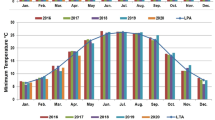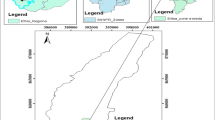Abstract
In eastern Himalayan region, growers cultivate many crops per unit area without following definite row proportions which resulted in lower productivity. Use of recent modern technologies in undulated topography is not feasible. Therefore, locally available resources were utilized for better water use, higher productivity and improved energy profitability in the maize–legume intercropping system. The studies were conducted at ICAR Research Complex for NEH Region, Basar, Arunachal Pradesh during the years 2010 and 2011. Maize, soybean and groundnut were planted solitary, and soybean and groundnut were intercropped with maize at 1:1, 1:2 and 1:5 row proportions. The maize grain yield was highest with solitary maize, but, intercrop yield was improved with higher row proportions. Maize equivalent yield and per day productivity were highest with 1:5 of maize–groundnut. Higher row proportion of legumes improved the water use but it was highest with solitary soybean (911.1 mm). The improvement of water use efficiency by 83.2 %, harvest monetary benefit by 87.5 %, benefit cost ratio by 92.3 % and energy productivity by 38.5 % with 1:5 of maize–groundnut over solitary maize. The energy input and output efficiency was higher with 1:2 of maize–groundnut, but output and net energy were superior under 1:2 of maize–soybean. The soil moisture content and solar radiation interception were 24.1 and 37.8 % which were improved with solitary soybean over solitary maize. Intercropping practices tender numerous advantages but improved understanding of the ecological mechanisms associated with intended row arrangement, including additional advantage of crop yield and water use, are needed to augment the benefit.







Similar content being viewed by others
References
Choudhary VK, Kumar PS, Kanwat M, Bhagawati R (2012) Improvement of jhum with crop model and carbon sequestration techniques to mitigate climate change in Eastern Himalayan Region. Indian J Agric Sci 4(4):181–189
Choudhary VK, Kumar PS, Bhagawati R (2013) Response of tillage and in situ moisture conservation on alteration of soil and morpho-physiological differences in maize under eastern Himalayan region of India. Soil Till Res 134:41–48
DOA (2008–2009) Department of agriculture, Government of Arunachal Pradesh, pp 1–120
Dhima KV, Lithourgidis AA, Vasilakoglou IB, Dordas CA (2007) Competition indices of common vetch and cereal intercrops in two seeding ratio. Field Crops Res 100:249–256
Hauggaard-Nielsen H, Jonsgaard B, Kinane J, Jensen ES (2007) Grain legume–cereal intercropping: the practical application of diversity, competition and facilitation in arable and organic cropping systems. Ren Agric Food Sys 23(1):3–12
Mucheru-Muna M, Pypers P, Mugendi D, Kung’u J, Mugwe J, Merckx R, Vanlauwe B (2010) A staggered maize–legume intercrop arrangement robustly increases crop yields and economic returns in the highlands of Central Kenya. Field Crops Res 115:132–139
Singh U, Saad AA, Singh SR (2008) Production potential, biological feasibility and economic viability of maize (Zea mays)-based intercropping system under rainfed conditions. Indian J Agric Sci 78(12):1023–1027
Banik P, Midya A, Sarkar BK, Ghose SS (2006) Wheat and chickpea intercropping systems in an additive series experiment: advantages and weed smothering. Eur J Agron 24:325–332
Sheoran P, Sardana V, Singh S, Bhusan B (2010) Bio-economic evaluation of rainfed maize (Zea mays)-based intercropping system with black gram (Vigna mungo) under different spatial arrangements. Indian J Agric Sci 80(3):244–247
Choudhary VK, Kumar PS, Bhagawati R (2013) Energy audit of rice production systems in different land forms in mid hills of Arunachal Pradesh. Indian Oryza 50(2):140–145
Pervanchon F, Bockstaller C, Girardin P (2002) Assessment of energy use in arable farming systems by means of an agro ecological indicator: the energy indicator. Agric Sys 72(2):149–172
Kanton RAL, Dennett MD (2004) Water uptake and use by morphologically contrasting maize/pea cultivars in sole and intercrops in temperate conditions. Exp Agric 40:201–214
Purcell LC, Ball RA, Reaper JD, Vories ED (2002) Radiation use efficiency and biomass production in soybean at different plant population densities. Crop Sci 42:172–177
Esengun K, Erdal G, Gunduz O, Erdal H (2007) An economic analysis and energy use in stake-tomato production in Tokat provience of Turkey. Ren Energy 32:1873–1881
SAS (2010) SAS procedure Guide. SAS Institute Incorporation. Second addition, Carry
Ogindo HO, Walker S (2005) Comparison of measured change in seasonal soil water content by rainfed maize-bean intercrop and component cropping in semi arid region in South Africa. Phy Chem Earth 30(11–16):799–808
Caviglia OP, Sadras VO, Andrade FH (2004) Intensification of agriculture in the south-eastern Pampas. I. Capture and efficiency in the use of water and radiation in double-cropped wheat–soybean. Field Crops Res 87:117–129
Woomer PL, Langat M, Tungani JO (2004) Innovative maize-legume intercropping results in above-and below-ground competitive advantages for understorey legumes. West Afr J Appl Ecol 6:85–94
Hugar HY, Palled YB (2008) Effect of intercropping vegetables on maize and associated weeds in maize-vegetable intercropping systems. Karnataka J Agric Sci 21(2):159–161
Hussain N, Shamsi IH, Khan S, Akbar H, Shah WA (2003) Effect of legume intercrops and nitrogen levels on the yield performance of maize. Asian J Plant Sci 2(2):242–246
Ahrens TD, Lobell DB, Ortiz-monasterio JI, Li Y, Matson PA (2010) Narrowing the agronomic yield gap with improved nitrogen use efficiency: a modeling approach. Ecol Appl 20(1):91–100
Padhi AK, Panigrahi RK (2006) Effect of intercrop and crop geometry on productivity, economics, energetic and soil fertility status of maize (Zea mays)-based intercropping system. Indian J Agron 51(3):174–177
Singh KP, V Prakash, Srinivas K, Srivastva AK (2008) Effect of tillage management on energy-use efficiency and economics of soybean (Glycine max) based cropping systems under the rainfed conditions in North-West Himalayan region. Soil Till Res 100:78–82
Acknowledgments
The authors wish to acknowledge the support provided by the Joint Director, Arunachal Pradesh Centre, Director, ICAR Research Complex for NEH Region, Barapani and field staff for this study.
Conflict of interest
The authors declare that they have no conflictof interest.
Author information
Authors and Affiliations
Corresponding author
Rights and permissions
About this article
Cite this article
Choudhary, V.K., Kumar, P.S. Productivity, Water Use and Energy Profitability of Staggered Maize–Legume Intercropping in the Eastern Himalayan Region of India. Proc. Natl. Acad. Sci., India, Sect. B Biol. Sci. 86, 547–557 (2016). https://doi.org/10.1007/s40011-014-0476-7
Received:
Revised:
Accepted:
Published:
Issue Date:
DOI: https://doi.org/10.1007/s40011-014-0476-7




